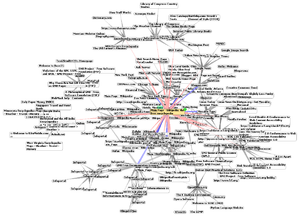The World Wide Web, from now on WWW, is a network of pages written in hypertext using the HTML markup language and connected to each other through links. In this way they form a single body of knowledge through which you can easily navigate. A web browser is required to access it.
- It was created by Tim Berners-Lee when he worked at CERN in Geneva, Switzerland. He runs the W3C, the body in charge of maintaining its operation.
Estructure
- The website is based on three standards to operate: the Uniform Resource Locator (URL), which is responsible for providing a unique address in order to locate each page; the Hyper Text Transfer Protocol (HTTP), which specifies how the information will be sent and received between the browser and the server; and Hyper Text Markup Language (HTML), a method to specify how this information should be viewed in the browser. They accompany the CSS in HTML, to define aspects of design. Or the JavaScript to make small programming in the web page. It has also become fashionable for games and websites with many visual effects, the Adobe Flash.
Operation
- Although today the terms Internet and the World Wide Web are commonly used in everyday speech as synonyms, they are not the same thing. Internet is a global network of interconnected computer networks. On the contrary, the Web is one of the services that is executed on the Internet network. It is a collection of interconnected documents and other resources, linked by hyperlinks and Uniform Resource Locator addresses. In summary, the Web is a software that works on the Internet.
-
The display of a web page usually begins when the user enters a URL through the keyboard in the web browser or when it follows a hyperlink to that page or resource. Then the web browser starts a series of pr

-
ocesses by exchanging unseen messages in order to get the page and display it. First, the part of the URL that contains the name of the server that contains the server page is translated to an IP address using a globally distributed database that contains domain equivalences – IP address and receives the name of DNS.
Risks
-
The Internet is associated to certain uses if it is misused, which has created distrust towards the medium between certain sectors. The first risk is related to privacy: the ease of uploading content, the amount of information and the institutions that work in the network make personal data available to other individuals. Bank phishing, the sustration of email accounts, disclosure of secrets through forums or social networks (only 20% of Facebook users are protected, for example) and spam or unwanted advertising that It invades privacy, some of the privacy problems may appear.
-
Finally, critical voices have been raised regarding young people, who may find inappropriate content, establish potentially dangerous contacts (such as pederasty networks) or develop addictions to video games and navigation, losing hours and study. Part of the laws on the WWW have to do precisely with the protection of children, allowing the installation of filters or penalizing cyber-crimes.

